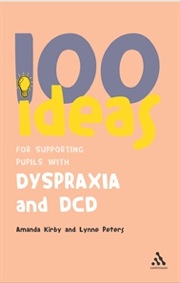Dyspraxia is a neurologically based developmental disability, present from birth, that can affect planning of movements and co-ordination. It is a motor planning disorder, not a muscular deficit. A child knows what they want their body to do but can't get their body to do it. Dyspraxia is believed to be an immaturity of parts of the motor cortex (area of the brain) that prevents messages from being properly transmitted to the body.
There are three (3) types of Developmental Dyspraxia - Oral, Verbal and Motor. A child with Dyspraxia can have one or a combination of all three types of Dyspraxia and in varying degrees of severity
Dyspraxia is a hidden handicap which affects up to 10% of the population with approximately 70% of those affected being boys. Children with this disability appear the same as any other child. It is only when a skill is performed that the disability is noticeable.
Dyspraxia does not impact on intelligence, children with Dyspraxia have average or above average intelligence. Dyspraxia is a specific learning disability and it can impact on behaviour and social skills.
Source: http://www.dyspraxia.com.au, http://en.wikipedia.org/wiki/Dyspraxia


